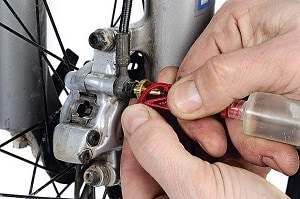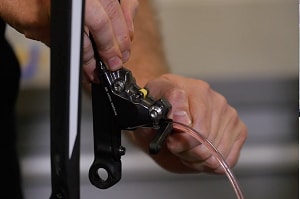An effective way to completely stop your bike, Disc brakes are considered an essential accessory for bikes used in sports, stunts, and more–especially when it comes to MTBs.
When used, bicycle disc brakes compress and slowly help the bike effectively use its brakes to come to a halt. Most bikes now use this part, made by various bike manufacturers, including the famed Shimano.
But these brakes get worn and need maintenance, making us wonder how to bleed Shimano disc brakes. We’ll be giving a step-by-step process on what to do to keep your brakes well-maintained.
Table of Contents
- 5 Simple Steps to Bleed Disc Brakes
- What to prepare
- Step 1: Prep the Bike.
- Step 2: Unfasten the Bleed port’s screw and attach the Bleed cup.
- Step 3: Connect your bleed hose and use a syringe to apply Mineral Oil.
- Step 4: Drain the oil into your brakes, pump it, and remove the hose.
- Step 5: Reinstall all the removed equipment and finish up.
- Frequently Asked Questions
- Conclusion
5 Simple Steps to Bleed Disc Brakes
What to prepare
To get started, here are a few things you’ll need for the bleed procedure.
- A set of Allen Keys and a 7mm Spanner
- Shimano Mineral Oil
- Shimano Bleed Kit
- Shimano Bleed block
- Plastic bags and a zip-tie
Step 1: Prep the Bike.
Before starting, position the bike on your work stand and remove the rear wheel and the brake pads. Remove and pull the pad retaining pin and brake pads out of the caliper before assembling your Bleed Block.
Ensure that the bar clamp is tightened enough throughout the process with a 4mm Allen Key to prevent the brake fluid from leaking. The lever must be horizontal, parallel to the ground.
Once prepared, you can begin bleeding your Shimano disc brakes.
Step 2: Unfasten the Bleed port’s screw and attach the Bleed cup.
Remove the bleed port screw on the lever and remove the O’ ring. You can use a 2.5mm Allen Key to remove the screw.
Once removed, insert the Shimano Bleed cup by carefully attaching it to the bleed port. Delicately work with the bleed cup, as the cup’s threads are easily damaged. Now remove the dust cap from the bleed nipple to continue.
Step 3: Connect your bleed hose and use a syringe to apply Mineral Oil.
Attach the bleed hose to the syringe filled with mineral oil, and squeeze it out to remove air bubbles. You can open the bleed fitting with a 7mm spanner and pump the oil inside.
Through the syringe, push more oil into your brake system. Once finished, stop before air bubbles enter the caliper and screw the bleed fitting back on.
Step 4: Drain the oil into your brakes, pump it, and remove the hose.
Dirty oil will be coming out of the hose during this process. Remove the syringe and attach a plastic bag using zip ties onto the hose to catch all the oil until clean oil comes out.
Reopen the bleed valve. Once half of the oil inside the bleed cup has drained, close your bleed fitting again and pump the brake lever a few times.
To ensure air bubbles wouldn’t get inside, reopen the valve, squeeze or pump your brake lever to the bar, and screw the valve back closed. Repeat at least four times, then finally close the bleed nipple and remove the bleed hose, tapping it to release any air bubbles.
Step 5: Reinstall all the removed equipment and finish up.
Finally, pump and release the brake lever a few times before leveling it horizontally. Install the plug on the bleed cup and remove it from the port before reinstalling the screw and O ring, and avoid tightening it too much when you do.
Remove the bleed block and reassemble all removed parts from the start of the process. Clean your bike– particularly the calipers and brakes, with a degreaser or a simple bike or vehicle cleaner.
Pump the brake lever to check its firmness and run a maintenance check before taking it out on a test ride, and there you have it! That’s how you bleed the disc brakes on your bike.
Frequently Asked Questions
How do you bleed Shimano brakes fast?
Bleeding your brakes is already a pretty easy task itself. It’s a straightforward job, yet with all the preparation it has, it gets troublesome. The key is to remove air from your brakes for quick and easy bleeding.
For that very purpose, you can use a DIY One Way Bleeding kit for Shimano that was designed to ensure that no air gets into your brakes, making sure you can bleed the disc brakes on your bike more efficiently.
How often do you bleed Shimano disc brakes?
Generally, bleeding brakes on a bike take a long time. Depending on the manufacturer, bleeding should be done for up to two years to ensure efficient bike performance and proper maintenance.
For Shimano, however, it’s recommended that you bleed your disc brakes every six months. It could also depend on the model, whether you’re bleeding Hydraulic bike brakes or when bleeding Shimano XT brakes.
Is it possible to bleed Shimano Disc brakes without the kit?
Without the kit, you can still bleed your disc brakes easily. Although, having the bleed kit on hand is more efficient since it has all the necessary tools for the Bleed procedure.
Simply detach your calipers and work on your bike’s bleed port. Allow the caliper to dangle to remove all air bubbles. You can use a syringe or a small DIY cup to bleed your bike’s disc brakes without the bleed kit.
Can I use other Mineral oil?
Mineral Oil is more regarded as a general term; used for any kind of vehicle; bikes, scooters, or even cars.
Once you use other brands, aside from Shimano’s specially optimized oil, it could destroy the seals in your brakes’ system and could damage your bike. Hence, using other brands of Mineral Oil for a Shimano is highly unrecommended.
Why should we bleed MTB disc brakes?
It’s a necessary process to make sure your brakes are working. Bleeding disc brakes on your mountain bike may take a lot of effort, yet it’s a vital part of MTB bike maintenance, especially for frequent bikers.
Bleeding mountain bike brakes helps remove air bubbles inside the brakes that can cause problems once you start using them. These air bubbles wear out your brakes and can disable them as well.
Conclusion
Ensuring your bike’s wellness, especially your brakes, is a big responsibility and is highly important as it also highlights your safety. So, without a doubt, bleeding your brakes is necessary for your Shimano bike’s maintenance.
When it comes to knowing how to bleed your bike’s brakes by yourself, it’s essential to find the proper tools and fulfill each bleed instruction with utmost care. It helps your bike last longer and provides a safe ride every time.

“I ride my bike to work for years, but is that enough? Our carelessness towards our surroundings has taken a toll on the environment. And now, everyone is responsible for changes; even the most minor contribution is counted. With this hope and spirit, I started with my partner to establish Biketoworkday to help more individuals commute to their work sites on their bikes.”








